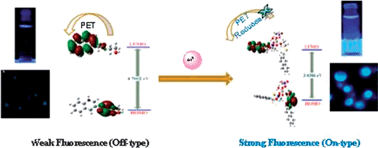A naphthalene exciplex based Al3+ selective on-type fluorescent probe for living cells at the physiological pH range: experimental and computational studies†
Abstract

* Corresponding authors
a
Department of Chemistry, The University of Burdwan, Burdwan 713104, India
E-mail:
ddas100in@yahoo.com
Fax: +91-342-2530452
Tel: +91-342-2533913
b Department of Microbiology, The University of Burdwan, Burdwan 713104, India

 Please wait while we load your content...
Something went wrong. Try again?
Please wait while we load your content...
Something went wrong. Try again?
A. Banerjee, A. Sahana, S. Das, S. Lohar, S. Guha, B. Sarkar, S. K. Mukhopadhyay, A. K. Mukherjee and D. Das, Analyst, 2012, 137, 2166 DOI: 10.1039/C2AN16233D
To request permission to reproduce material from this article, please go to the Copyright Clearance Center request page.
If you are an author contributing to an RSC publication, you do not need to request permission provided correct acknowledgement is given.
If you are the author of this article, you do not need to request permission to reproduce figures and diagrams provided correct acknowledgement is given. If you want to reproduce the whole article in a third-party publication (excluding your thesis/dissertation for which permission is not required) please go to the Copyright Clearance Center request page.
Read more about how to correctly acknowledge RSC content.
 Fetching data from CrossRef.
Fetching data from CrossRef.
This may take some time to load.
Loading related content
